WS-9153U-IT
Wireless 915 MHz
Radio-controlled Weather Station
Instruction Manual
2
TABLE OF CONTENTS
Topic Page
Inventory of Contents/Additional Equipment 3
About WWVB 3
Quick Set-Up Guide 4
Detailed Set-Up Guide
Battery installation 5
Program Mode
Program Sequence and Default Settings 6
Function Keys 6
Setting the LCD Contrast 7
Setting the Time Zone 7-8
Daylight Saving Time Setting 8
Radio-controlled Time Setting 9
12/24-hour Time Setting 9
Setting the Time 10-11
Setting the Year, Day and Month 11
Setting the Snooze 12
Setting the Temperature Format 12
Setting the Forecast Sensitivity 13
Features
Weather Forecast Icons and Tendency Arrows 14-15
Indoor Temperature, Humidity, & Comfort
Level Indicator
15-16
Outdoor Temperatures 16
Minimum & Maximum Records (Indoor,
Outdoor, & Resetting)
16-17
Additional Remote Control Sending Units (Set-Up, Viewing,
& Operation)
18-19
Mounting 19-21
Troubleshooting 22-23
Maintenance & Care 23
Specifications 24
Warranty Information 25-26
3
INVENTORY OF CONTENTS
1. The Wireless Weather Station/ (Figure 1).
2. One remote temperature sensor with mounting bracket (Figure 2).
3. Three each, ½” Philips screws.
4. One strip double-sided adhesive tape.
5. Instruction manual and warranty card.
ADDITIONAL EQUIPMENT (not included)
1. Two fresh AA 1.5V Alkaline batteries for the Wireless Weather Station.
2. Two fresh AA 1.5V Alkaline batteries for the remote temperature sensor.
3. One, Philips screwdriver for mounting.
ABOUT WWVB (Radio Controlled Time)
The NIST (National Institute of Standards and Technology—Time and Frequency Division)
WWVB radio station is located in Ft. Collins, Colorado, and transmits the exact time and date
Figure 1
Figure 2
Mounting
Bracket
TX29U-IT remote
temperature sensor
INSTANT TRANSMISSION is the state-
of-the-art new wireless transmission
technology, exclusively designed and
developed by LA CROSSE
TECHNOLOGY. INSTANT
TRANSMISSION offers you an
immediate update (every 4 seconds!) of
all your outdoor data measured from
the sensors: follow your climatic
variations in real-time!
This product offers:
4
signal continuously throughout the United States at 60 kHz. The signal can be received up to
2,000 miles away through the internal antenna in the Weather Station. However, due to the
nature of the Earth’s Ionosphere, reception is very limited during daylight hours. The Weather
Station will search for a signal every night when reception is best. The WWVB radio station
derives its signal from the NIST Atomic clock in Boulder, Colorado. A team of atomic physicists
is continually measuring every second, of every day, to an accuracy of ten billionths of a second
per day. These physicists have created an international standard, measuring a second as
9,192,631,770 vibrations of a Cesium-133 atom in a vacuum. For more information on the
atomic clock and WWVB please see the NIST website at
http://www.boulder.nist.gov/timefreq/stations/wwvb.htm
.
QUICK SET-UP GUIDE
Hint: Use good quality Alkaline Batteries and avoid rechargeable batteries.
1. Have the Wireless Weather Station and remote temperature sensor 3 to 5 feet apart.
2. Batteries should be out of both units for 10 minutes.
3. Place the batteries into the remote temperature sensor first then into the indoor
weather station.
(All remote temperature sensors must be started before the Wireless Weather Station)
4. DO NOT PRESS ANY BUTTONS FOR 15 MINUTES.
In this time the Wireless Weather Station and remote temperature sensor will start to talk to each
other and the display will show both the indoor temperature and humidity, and an outdoor
temperature. If the Wireless Weather Station does not display both temperatures after the 15
minutes please retry the set up as stated above. After both indoor and outdoor temperatures are
displayed for 15 minutes you can place your remote temperature sensor outdoor and set your
time.
The remote temperature sensor should be placed in a dry, shaded area. The temperature
sensor has a range of 330 feet. Keep in mind that the 330 feet is in open air with no
obstructions and that radio waves DO NOT curve around objects. Actual transmission range will
vary depending on what is in the path of the signal. Each obstruction (roof, walls, floors,
ceilings, thick trees, etc.) will effectively cut signal range in half.
Example: A Wireless Weather Station with a 330 feet range is mounted on an interior wall, so
that the signal has to pass through one interior wall, one exterior wall, and across the 10 feet
width of the room between the 2 walls. The first wall will reduce the range to 165 feet, and the
second wall will reduce the range to 87 feet. Factoring in the 10 foot room, this leaves a
maximum of 77 feet of remaining signal range.
This allowance is typically enough for a frame wall with non-metallic siding; however certain
materials can reduce range even further. Metal siding, stucco, and some types of glass can
reduce signal range by as much as ¾ or more, compared to the ½ reduction typical of most
obstructions. It is possible to receive a signal through these materials, however maximum range
will be much less due to their tendency to absorb or reflect a much larger portion of the sensor’s
signal.
To complete the set up of your Wireless Weather Station after the 15 minutes have passed
please follow the steps that follow in the Detailed Set-Up Guide.


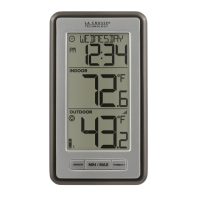
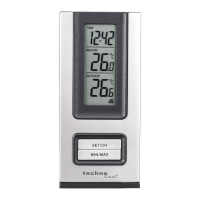
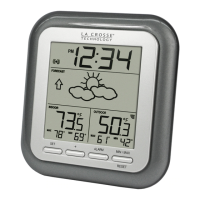
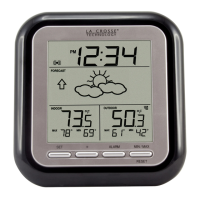
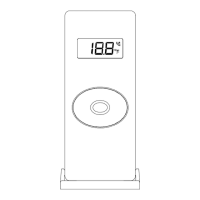


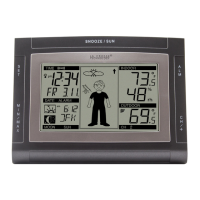

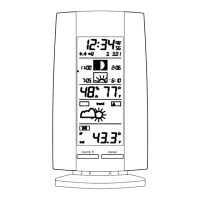
